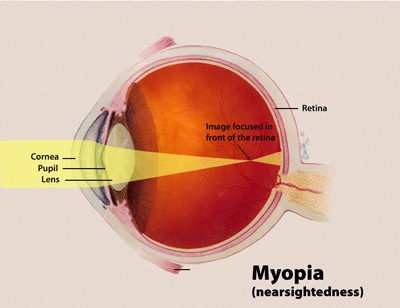“You wore glasses before?”
“Yup.”
“Are you wearing contact lenses right now?”
“Nope, I only wear them when I sleep.”
“What?! You can do that?”
That was the typical response I got when people found that I wore contact lenses to sleep. At a very young age, I developed a common eye condition known as nearsightedness or Myopia; I could only see close objects clearly and objects far away appeared blurry. As my eyesight got worse at an abnormally fast rate, my optometrist (a doctor specializing in eye care) recommended me to wear “night lenses” to correct my vision, a practice known as Orthokeratology (Ortho-k).

Some Ortho-K lenses that I own
Copyright: Grace Lam
How do you develop Myopia?
Myopia is typically an inherited condition and often develops in children ages 8-12. This condition progresses very quickly at young ages due to the rapid growth of tissues in the eye while the eye is constantly elongating (growing in the forward-backward direction). Also, engaging in “close-up activities” such as reading and using the computer for extended periods of time can speed up the development of nearsightedness.
In order to see objects clearly, the image of the object must be focused on the retina. This is done by the lens in your eye (see image below), as it thickens when looking at close objects and flattens when looking at objects far away. According to researchers at the Ohio State University College of Optometry, the lens in patients with Myopia do not thin or flatten out like those of normal individuals. This causes the image to be focused in front of the retina rather than directly on it, thus resulting in a blurred image of objects that are far away.

The main areas of the eye affected in Myopia
by the National Eye Institute via Wikimedia Commons
How does Orthokeratology help?
The purpose of Ortho-k is to provide vision correction without the complications of surgeries and since changes cannot be made to the lens without opening up the eye, the shape of the cornea is altered instead (see image above). This is accomplished by wearing specially fitted contact lenses when sleeping. As the cornea is also an important structure that helps focus images perceived by the eye, altering its shape effectively can compensate for the shortcomings of the lens and ultimately refocus the image back on the retina. As a result, myopic patients can once again see objects at close and far distances clearly. Check out the video below for more on Myopia and Orthokeratology.

Youtube video by EyeContactOptometry
Research has shown that the use of Ortho-k lenses slow the progression of myopia, which is important to many myopic patients. I prefer night lenses because I can’t feel them when I sleep and when I take them off in the morning, I have 20/20 vision just like everyone else. Orthokeratology may not be the right treatment for everyone, but it can be advantageous for those who find glasses and day lenses inconvenient.
– Grace Lam


